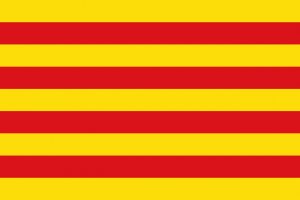Language/Catalan/Grammar/Basic-Sentence-Structure
| ◀️ Alphabet and Pronunciation — Previous Lesson | Next Lesson — Common Greetings ▶️ |
Introduction[edit | edit source]
Welcome to the lesson on basic sentence structure in Catalan! In this lesson, we will explore the fundamental elements of a sentence in Catalan, including the subject-verb-object order. Understanding the basic sentence structure is essential for forming simple sentences and expressing ideas in Catalan. Throughout this lesson, we will provide you with clear explanations, numerous examples, and engaging exercises to help you grasp this concept fully. So let's dive in and start building your knowledge of Catalan grammar!
Subject-Verb-Object Order[edit | edit source]
In Catalan, like many other Romance languages, the basic sentence structure follows a subject-verb-object (SVO) order. This means that the subject of the sentence comes first, followed by the verb, and then the object. Let's break down each component and explore its role in a sentence.
Subject[edit | edit source]
The subject of a sentence is the person, thing, or entity that performs the action or is being described. It can be a noun or a pronoun. Here are a few examples:
- El gat menja peix. (The cat eats fish.)
- La Maria estudia. (Maria studies.)
In the first example, "El gat" (The cat) is the subject, and in the second example, "La Maria" (Maria) is the subject. As you can see, the subject is placed before the verb in both sentences.
Verb[edit | edit source]
The verb is the action or state of being in a sentence. It expresses what the subject is doing or experiencing. Verbs can be conjugated to match the subject's person, number, and tense. Let's look at some examples:
- El gat menja peix. (The cat eats fish.)
- La Maria estudia. (Maria studies.)
In both examples, "menja" (eats) and "estudia" (studies) are the verbs. They indicate the action being performed by the subject.
Object[edit | edit source]
The object is the person or thing that receives the action of the verb. It can be a noun or a pronoun. Let's see some examples:
- El gat menja peix. (The cat eats fish.)
- La Maria estudia matemàtiques. (Maria studies mathematics.)
In the first example, "peix" (fish) is the object of the verb "menja" (eats). In the second example, "matemàtiques" (mathematics) is the object of the verb "estudia" (studies). The objects come after the verb in these sentences.
Now that we have examined each component of the basic sentence structure in Catalan, let's practice constructing sentences using this order.
Practice Exercises[edit | edit source]
1. Rearrange the words to form a grammatically correct sentence in Catalan.
a) menja / gat / peix / El b) estudia / Maria / ciències / La c) beu / Anna / aigua / La d) escriu / Gerard / llibre / Un e) juguen / nens / parc / Els
Solution: a) El gat menja peix. (The cat eats fish.) b) La Maria estudia ciències. (Maria studies science.) c) La Anna beu aigua. (Anna drinks water.) d) Un Gerard escriu llibre. (Gerard writes a book.) e) Els nens juguen al parc. (The children play in the park.)
2. Translate the following sentences from English to Catalan.
a) The dog chases the cat. b) I eat an apple. c) We watch a movie. d) You write a letter. e) She sings a song.
Solution: a) El gos persegueix el gat. b) Jo menjo una poma. c) Nosaltres mirem una pel·lícula. d) Tu escrius una carta. e) Ella canta una cançó.
3. Fill in the blank with the correct form of the verb in parentheses.
a) Jo _______ (cantar) una cançó. b) Ell _______ (estudiar) matemàtiques. c) Nosaltres _______ (ballar) a la festa. d) Vós _______ (menjar) pa amb tomàquet. e) Els nens _______ (jugar) al parc.
Solution: a) Jo canto una cançó. (I sing a song.) b) Ell estudia matemàtiques. (He studies mathematics.) c) Nosaltres ballam a la festa. (We dance at the party.) d) Vós menjau pa amb tomàquet. (You eat bread with tomato.) e) Els nens juguen al parc. (The children play in the park.)
Regional Variations and Cultural Insights[edit | edit source]
While the basic sentence structure in Catalan follows the subject-verb-object order, it's worth mentioning that there can be some regional variations in the usage or understanding of this structure. For example, in some dialects of Catalan, particularly in the Balearic Islands, the subject can be omitted when it is clear from the context. This omission is known as "pro-drop" and is a common feature in Romance languages.
Additionally, it's interesting to note that the basic sentence structure in Catalan has historical roots in Latin, the predecessor of the Romance languages. Catalan, along with Spanish, Italian, French, and other Romance languages, evolved from Latin and inherited this subject-verb-object order. Understanding the historical development of the language can provide valuable insights into its grammar and structure.
Conclusion[edit | edit source]
Congratulations! You have successfully learned about the basic sentence structure in Catalan. You now have a solid foundation for forming simple sentences in Catalan, using the subject-verb-object order. Make sure to practice constructing sentences and applying your knowledge in various contexts. As you continue your language learning journey, remember that understanding the grammar of a language is crucial for effective communication. Keep up the good work, and soon you'll be able to express yourself confidently in Catalan!
Sources[edit | edit source]
- Catalan syntax - Wikipedia
- Catalan Tutorial: Basic Catalan Phrases, Vocabulary, and Grammar
- Catalan Grammar TOC
Other Lessons[edit | edit source]
- Indefinite Articles in Catalan
- Adjective Agreement
- How to use "can" in Catalan
- Adjectives
- Alphabet and Pronunciation
- Regular Verbs
- Interrogative Words in Catalan
- Plural
- How to say "there is" in Catalan
- Questions
| ◀️ Alphabet and Pronunciation — Previous Lesson | Next Lesson — Common Greetings ▶️ |


